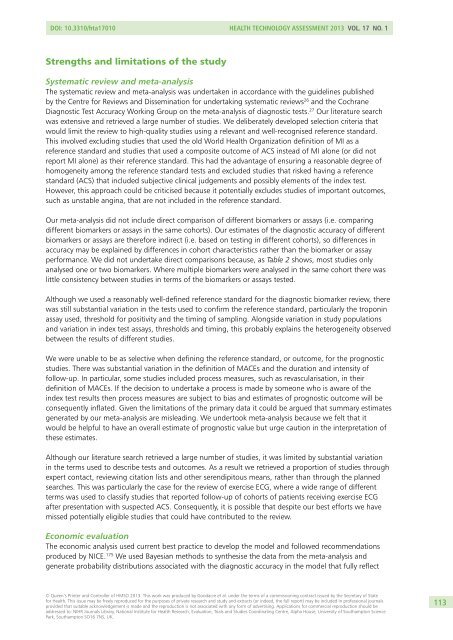Systematic review, meta-analysis and economic modelling of ...
Systematic review, meta-analysis and economic modelling of ...
Systematic review, meta-analysis and economic modelling of ...
Create successful ePaper yourself
Turn your PDF publications into a flip-book with our unique Google optimized e-Paper software.
DOI: 10.3310/hta17010 Health Technology Assessment 2013 Vol. 17 No. 1Strengths <strong>and</strong> limitations <strong>of</strong> the study<strong>Systematic</strong> <strong>review</strong> <strong>and</strong> <strong>meta</strong>-<strong>analysis</strong>The systematic <strong>review</strong> <strong>and</strong> <strong>meta</strong>-<strong>analysis</strong> was undertaken in accordance with the guidelines publishedby the Centre for Reviews <strong>and</strong> Dissemination for undertaking systematic <strong>review</strong>s 26 <strong>and</strong> the CochraneDiagnostic Test Accuracy Working Group on the <strong>meta</strong>-<strong>analysis</strong> <strong>of</strong> diagnostic tests. 27 Our literature searchwas extensive <strong>and</strong> retrieved a large number <strong>of</strong> studies. We deliberately developed selection criteria thatwould limit the <strong>review</strong> to high-quality studies using a relevant <strong>and</strong> well-recognised reference st<strong>and</strong>ard.This involved excluding studies that used the old World Health Organization definition <strong>of</strong> MI as areference st<strong>and</strong>ard <strong>and</strong> studies that used a composite outcome <strong>of</strong> ACS instead <strong>of</strong> MI alone (or did notreport MI alone) as their reference st<strong>and</strong>ard. This had the advantage <strong>of</strong> ensuring a reasonable degree <strong>of</strong>homogeneity among the reference st<strong>and</strong>ard tests <strong>and</strong> excluded studies that risked having a referencest<strong>and</strong>ard (ACS) that included subjective clinical judgements <strong>and</strong> possibly elements <strong>of</strong> the index test.However, this approach could be criticised because it potentially excludes studies <strong>of</strong> important outcomes,such as unstable angina, that are not included in the reference st<strong>and</strong>ard.Our <strong>meta</strong>-<strong>analysis</strong> did not include direct comparison <strong>of</strong> different biomarkers or assays (i.e. comparingdifferent biomarkers or assays in the same cohorts). Our estimates <strong>of</strong> the diagnostic accuracy <strong>of</strong> differentbiomarkers or assays are therefore indirect (i.e. based on testing in different cohorts), so differences inaccuracy may be explained by differences in cohort characteristics rather than the biomarker or assayperformance. We did not undertake direct comparisons because, as Table 2 shows, most studies onlyanalysed one or two biomarkers. Where multiple biomarkers were analysed in the same cohort there waslittle consistency between studies in terms <strong>of</strong> the biomarkers or assays tested.Although we used a reasonably well-defined reference st<strong>and</strong>ard for the diagnostic biomarker <strong>review</strong>, therewas still substantial variation in the tests used to confirm the reference st<strong>and</strong>ard, particularly the troponinassay used, threshold for positivity <strong>and</strong> the timing <strong>of</strong> sampling. Alongside variation in study populations<strong>and</strong> variation in index test assays, thresholds <strong>and</strong> timing, this probably explains the heterogeneity observedbetween the results <strong>of</strong> different studies.We were unable to be as selective when defining the reference st<strong>and</strong>ard, or outcome, for the prognosticstudies. There was substantial variation in the definition <strong>of</strong> MACEs <strong>and</strong> the duration <strong>and</strong> intensity <strong>of</strong>follow-up. In particular, some studies included process measures, such as revascularisation, in theirdefinition <strong>of</strong> MACEs. If the decision to undertake a process is made by someone who is aware <strong>of</strong> theindex test results then process measures are subject to bias <strong>and</strong> estimates <strong>of</strong> prognostic outcome will beconsequently inflated. Given the limitations <strong>of</strong> the primary data it could be argued that summary estimatesgenerated by our <strong>meta</strong>-<strong>analysis</strong> are misleading. We undertook <strong>meta</strong>-<strong>analysis</strong> because we felt that itwould be helpful to have an overall estimate <strong>of</strong> prognostic value but urge caution in the interpretation <strong>of</strong>these estimates.Although our literature search retrieved a large number <strong>of</strong> studies, it was limited by substantial variationin the terms used to describe tests <strong>and</strong> outcomes. As a result we retrieved a proportion <strong>of</strong> studies throughexpert contact, <strong>review</strong>ing citation lists <strong>and</strong> other serendipitous means, rather than through the plannedsearches. This was particularly the case for the <strong>review</strong> <strong>of</strong> exercise ECG, where a wide range <strong>of</strong> differentterms was used to classify studies that reported follow-up <strong>of</strong> cohorts <strong>of</strong> patients receiving exercise ECGafter presentation with suspected ACS. Consequently, it is possible that despite our best efforts we havemissed potentially eligible studies that could have contributed to the <strong>review</strong>.Economic evaluationThe <strong>economic</strong> <strong>analysis</strong> used current best practice to develop the model <strong>and</strong> followed recommendationsproduced by NICE. 175 We used Bayesian methods to synthesise the data from the <strong>meta</strong>-<strong>analysis</strong> <strong>and</strong>generate probability distributions associated with the diagnostic accuracy in the model that fully reflect© Queen’s Printer <strong>and</strong> Controller <strong>of</strong> HMSO 2013. This work was produced by Goodacre et al. under the terms <strong>of</strong> a commissioning contract issued by the Secretary <strong>of</strong> Statefor Health. This issue may be freely reproduced for the purposes <strong>of</strong> private research <strong>and</strong> study <strong>and</strong> extracts (or indeed, the full report) may be included in pr<strong>of</strong>essional journalsprovided that suitable acknowledgement is made <strong>and</strong> the reproduction is not associated with any form <strong>of</strong> advertising. Applications for commercial reproduction should beaddressed to: NIHR Journals Library, National Institute for Health Research, Evaluation, Trials <strong>and</strong> Studies Coordinating Centre, Alpha House, University <strong>of</strong> Southampton SciencePark, Southampton SO16 7NS, UK.113
















